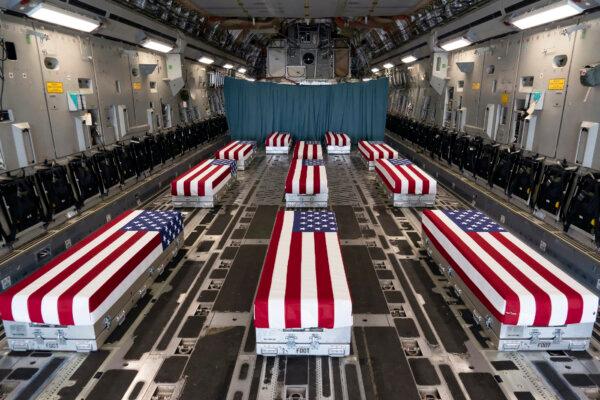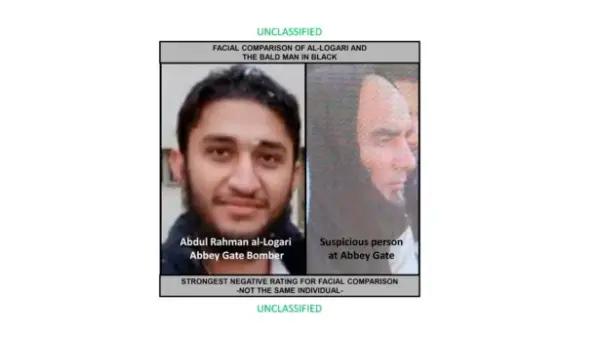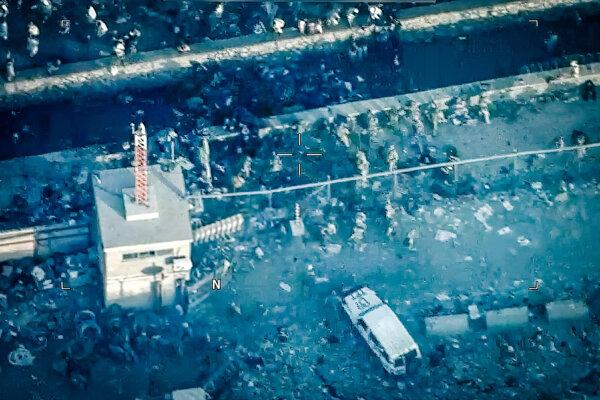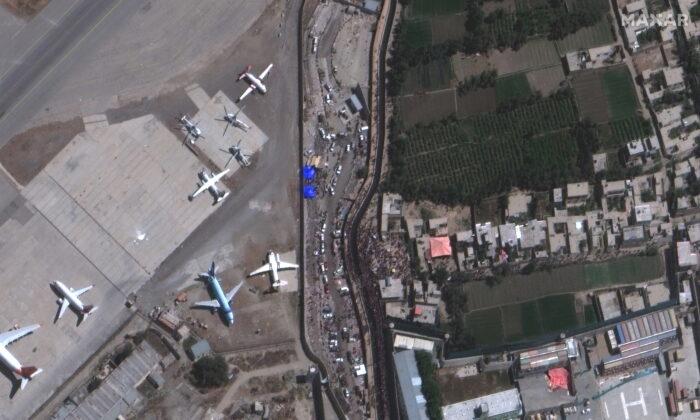The suicide bombing at the Kabul airport that killed U.S. troops and Afghans in August 2021 was not preventable, according to a new review by U.S. Central Command.
The findings, released Monday, clarified that a “bald man in black” spotted by U.S. service members the morning of the attack was not the bomber and refuted the assertions by some service members who believed they had a chance to take out the would-be bomber but did not get approval.
In the press release, the U.S. military, for the first time, confirmed that the bomber was Abdul Rahman al-Logari, an Islamic State militant who had been in an Afghan prison but was released by the Taliban when it seized control of the country far more rapidly than U.S. intelligence had foreseen.
Panic broke out as the Taliban seized Kabul, the Afghan capital, turning its airport into the site of an impromptu air evacuation guarded by U.S. forces hurriedly deployed for the task.
The review concluded that the attack at Abbey Gate “was not preventable at the tactical level without degrading the mission to maximize the number of evacuees,” thereby confirming the conclusion of an initial 2021 investigation.
The review also focused on the Taliban’s use of excessive force and the decision to consolidate the defensive perimeter around Abbey Gate before the attack.
“Leaders at Abbey Gate were present, engaged, and made sound tactical decisions,” the review concluded.
The review was ordered in September by Army Gen. Eric Kurilla, head of U.S. Central Command, largely due to criticism of the initial investigation and assertions that the deadly assault could have been prevented.

Bald Man in Black
The bombing occurred during the final chaotic days of the U.S. military withdrawal from Afghanistan. Thirteen U.S. service members and 170 Afghans were killed in the attack.The calamity triggered widespread debate and congressional criticism, fueled by the emotional testimony from a Marine who said snipers believed they saw the bomber earlier in the day but couldn’t get approval to take him out.
Former Marine Sgt. Tyler Vargas-Andrews—who could not be interviewed during the first investigation due to his severe injuries—told the House Foreign Affairs Committee in March that personnel aiding in the evacuation were given descriptions of men believed to be plotting an attack.
Mr. Vargas-Andrews said he and others saw a bald man who matched the description of one of the suspects. They alerted their superiors but were told to stand down.

In a detailed briefing given to a small number of reporters, members of the U.S. Central Command team that conducted the review showed photos of the bald man identified by U.S. snipers and compared them with photos of Mr. al-Logari.
The review team, who spoke to reporters on condition of anonymity, described using facial recognition and other analysis tools that they said confirmed those were two different men.
“For the past two years, some service members have claimed that they had the bomber in their sights and they could have prevented the attack. We now know that is not correct,” said a team member.
The team said that the bald man in black was first seen around 7 a.m. but troops lost sight of him by 10 a.m. The bombing took place at 17:50 p.m., nearly eight hours later. According to U.S. Central Command, Mr. al-Logari didn’t get to Abbey Gate until “very shortly” before he detonated himself, however the precise moment remains classified.
The review team said their investigation could not completely rule out claims that the Taliban did a test run of the bombing several days earlier. Three men were seen carrying a large bag in the area, but the team deemed it unlikely that this would have been a test run for this sort of attack.

Families Briefed
Family members of those killed in the blast have been briefed about the review over the past two weekends. They said they were relieved to finally get more details about their loved ones’ deaths after the initial briefings left them with many answers.However, some remain unconvinced.
“For me, personally, we are still not clear. I believe Tyler saw what Tyler saw and he knows what he saw. And it was not the guy that they were claiming was the man in black,” Jim McCollum, the father of Marine Lance Cpl. Rylee McCollum told The Associated Press.
He said the team went into “pretty good detail, not trying to discredit Tyler, but effectively saying he was wrong. However, that ended up being as clear as mud to us.”
Mark Schmitz, the father of Marine Lance Cpl. Jared Schmitz questioned the photo itself.

“They kept saying this is who Tyler Vargas-Andrews was looking at and we were thinking to ourselves, ‘well, that’s interesting. Why is this a picture of a picture from a Canon camera?’” he said. “To me it felt like they were trying to find the guy in those cameras that may have come close to looking like somebody of interest that they can try to sell to us.”
Mr. Schmitz said that Gen. Kurilla attended the latest briefing to the families and apologized for how they had been treated during the initial probe.
It took the Army nearly three years before Mr. Schmitz finally received the details of his son’s death: Where exactly he was when the bomb went off and that he was unconscious almost immediately after being hit.
Not Preventable
Fifty-two service members who were directly involved in evacuation operations at Abbey Gate were interviewed, including 12 who were previously unavailable due to their injuries. This brings the total of interviewed service members to 190 when the previous investigation—completed in November 2021—is included.Service members were asked about 64 questions, and the sessions lasted between one hour and seven hours long, the team said.
In general terms, the team said the review overall confirmed the findings of the initial investigation: That the bombing was not preventable given the situation and that reports of threats before the bombing were too vague to base decisions on.
Critics have slammed the Biden administration for the chaotic retreat out of Afghanistan, during which $7 billion of military equipment was left behind.
While the United States was able to get more than 130,000 civilians out of the country during the panic when the Taliban took control of the government, there were horrifying images of desperate Afghans clinging to military aircraft as they lifted off.







